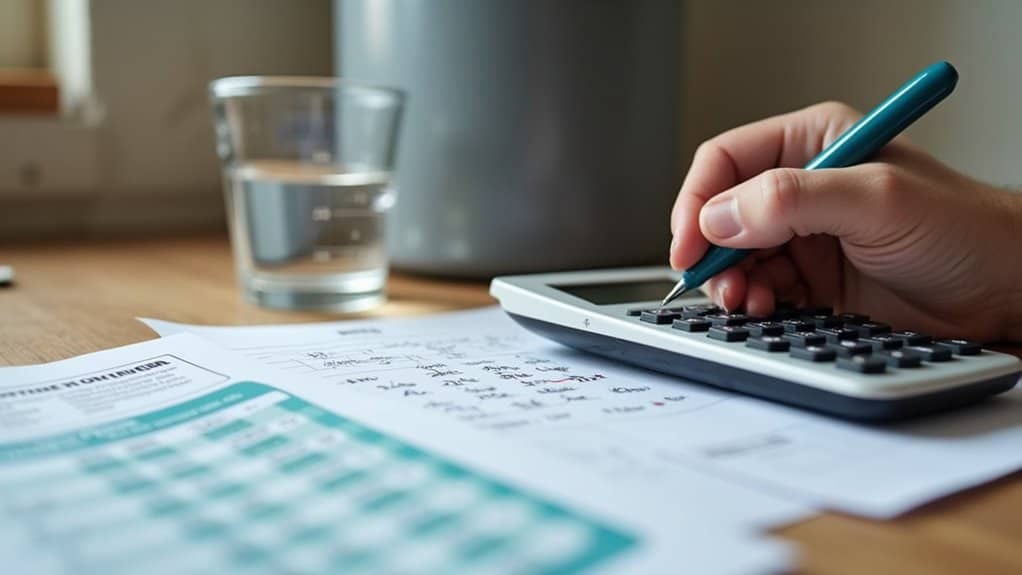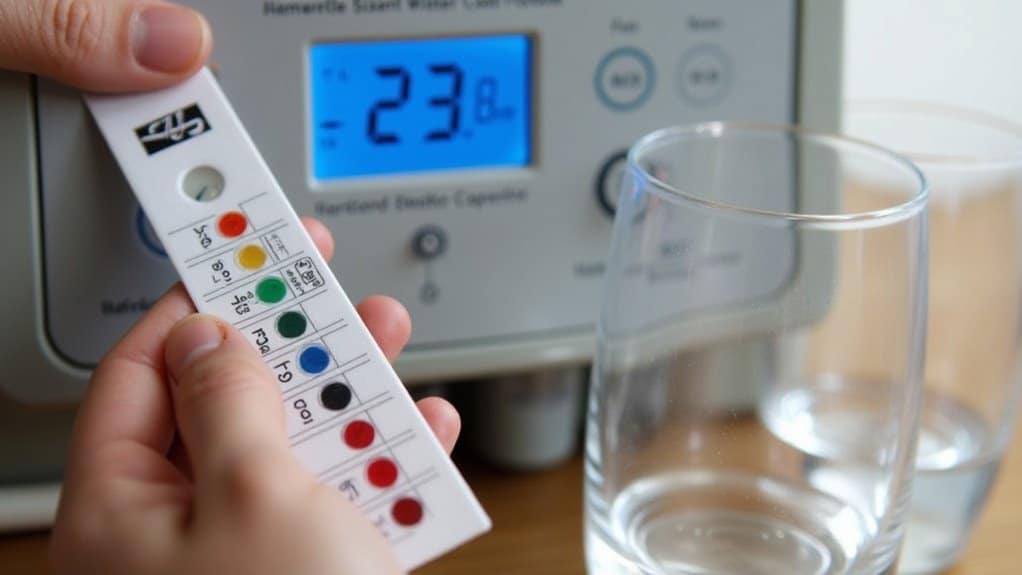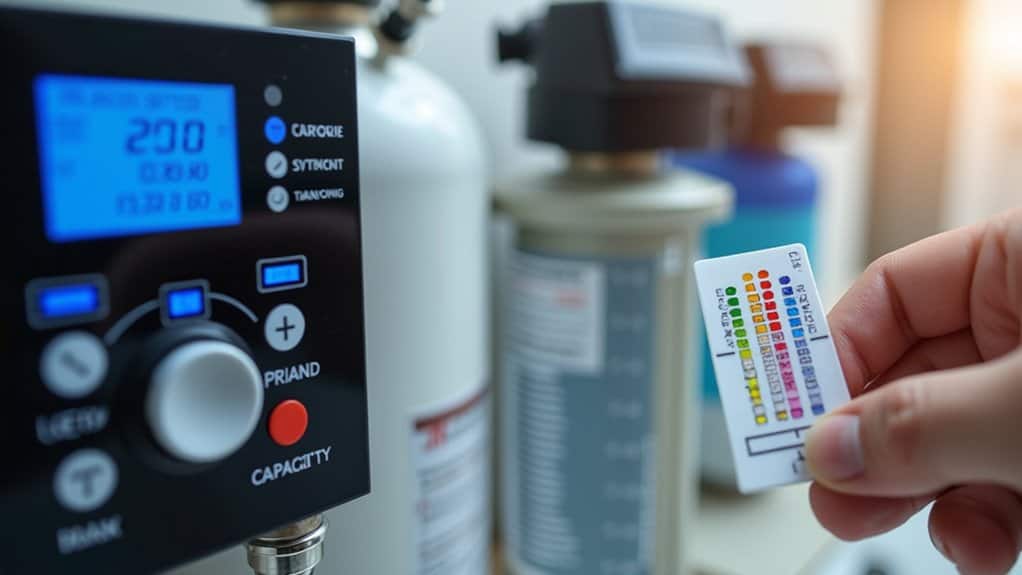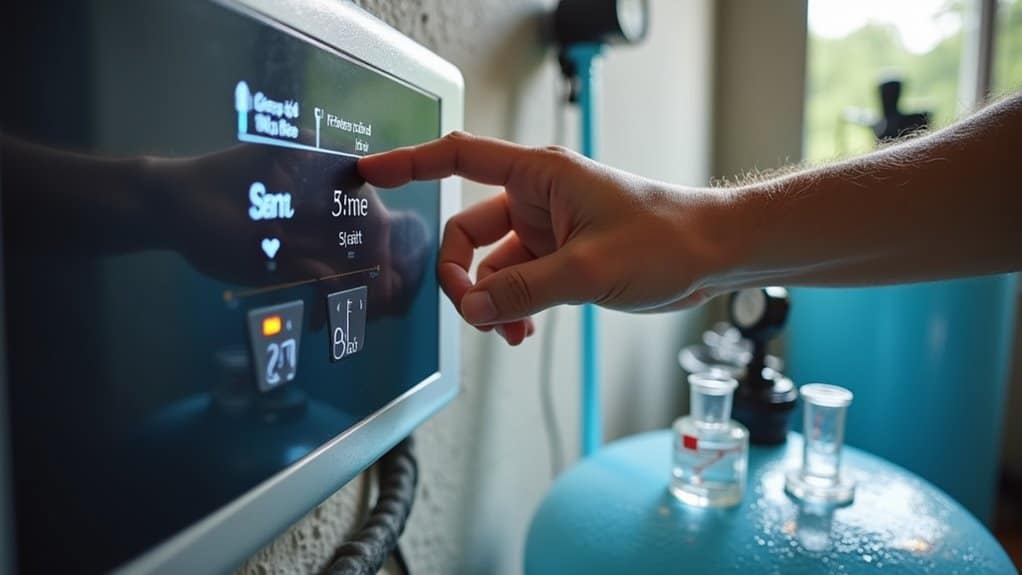We’ve found the perfect water softener sizing is key to true “set it and forget it” performance. Calculate your daily water usage (75 gallons per person) and multiply by your water hardness level (GPG), then add 4 grains for each 1 ppm of iron present. For a standard household, a 30,000-40,000 grain system typically works best. Proper sizing prevents both excessive regeneration and stagnation, ensuring years of maintenance-free operation.
Key Takeaways
- Calculate daily grain removal by multiplying household water usage (75 gallons/person) by water hardness level in grains per gallon.
- Choose a system with 30,000-40,000 grain capacity for standard households, ensuring it handles weekly requirements without frequent regeneration.
- Add 4 grains per 1 ppm of iron when calculating total compensated hardness to account for all contaminants.
- Select demand-based regeneration systems that activate only when needed to optimize salt usage and extend resin life.
- Install a properly sized twin-tank configuration to ensure continuous soft water availability while allowing proper regeneration cycles.
Why Proper Water Softener Sizing Matters for Your Home

When selecting a water softener for your home, proper sizing represents the most critical factor determining system performance and longevity.
Undersized systems fail during peak usage, allowing hard water to bypass treatment when multiple fixtures operate simultaneously. They also regenerate too frequently, wearing out components prematurely, which can lead to appliance damage and increased repair costs.
Conversely, oversized systems waste salt and water during excessive regeneration cycles. This increases operating costs and shortens resin lifespan unnecessarily.
Correct sizing ensures complete mineral removal, consistent water quality, optimal flow rates, and balanced resource consumption. Accurately measured water hardness levels in grains per gallon (GPG) provide essential data for determining appropriate system capacity.
It’s not just about current needs—proper sizing future-proofs your investment against household growth and changing water demands.
The Simple Formula for Calculating Your Ideal Grain Capacity

Determining your water softener’s ideal grain capacity begins with a straightforward mathematical formula that accounts for your household’s specific needs. We multiply your daily water usage by your water hardness level (measured in grains per gallon) to calculate daily grain removal requirements, then multiply by seven for weekly capacity.
- Daily water usage (gallons) × Water hardness (GPG) = Daily grain removal
- Daily grain removal × 7 days = Weekly capacity requirement
Standard households (4 people) typically need 30,000-40,000 grain systems. Additionally, the ideal water softener capacity is essential for ensuring efficient performance.
Add 4 grains per 1 ppm of iron if present in your water. For most homes, we recommend selecting a system slightly larger than your calculated needs to accommodate peak usage periods. Testing your water hardness is crucial for accurate sizing since hardness levels vary significantly by geographic location.
Matching Water Hardness Levels to System Requirements

Water hardness levels directly impact your softener system requirements, making proper matching essential for optimal performance.
We classify water as soft (0-60 mg/L), moderately hard (61-120 mg/L), hard (121-180 mg/L), or very hard (180+ mg/L).
When sizing your system, calculate total compensated hardness by adding your base hardness plus adjustments for other contaminants.
For instance, add 4 grains for every 1 ppm of iron present.
Using a Dial-a-Softness Valve allows you to customize your water hardness levels for optimal comfort and system efficiency.
Professional testing provides precise readings of calcium, magnesium, and iron levels.
After installation, retest to verify effectiveness.
Remember that regional variations exist—well water typically contains higher mineral content than municipal sources.
Balancing Regeneration Frequency With Long-Term Performance

Proper regeneration frequency stands at the core of water softener longevity and efficiency.
We’ve found that balancing this crucial function requires understanding both your system type and household demand patterns.
- Demand-based systems optimize salt usage by regenerating only when needed, reducing waste and extending resin life. Additionally, correct sizing plays a pivotal role in achieving maximum efficiency and cost savings.
- Undersized units regenerate too frequently, accelerating component wear and increasing operating costs.
- Oversized systems risk stagnation in resin beds, potentially compromising water quality.
- Twin-tank configurations provide continuous soft water service while allowing proper regeneration cycles.
A correctly sized softener with approximately 75 gallons per person daily usage calculation ensures consistent performance without excessive regeneration cycles.
For optimal performance, we recommend professional calibration of your salt dosage and regeneration intervals based on your water hardness and household usage patterns.
Frequently Asked Questions
Can Water Softeners Remove Contaminants Other Than Hardness Minerals?
No, we don’t recommend water softeners for contaminant removal beyond hardness minerals. They’re ineffective against bacteria, chemicals, heavy metals, and dissolved solids. Consider additional filtration systems for comprehensive water treatment.
How Often Should I Add Salt to My Water Softener?
We recommend checking your salt level monthly and adding salt when it falls below the 1/3 mark. Most systems need refilling every 4-8 weeks, depending on water hardness and household usage.
Will a Water Softener Affect My Home’s Water Pressure?
Yes, water softeners can reduce pressure if they’re undersized, clogged, or improperly maintained. We recommend testing with the bypass valve and regularly cleaning resin beds to maintain optimal flow.
Can I Install a Water Softener Myself or Need Professional Help?
We recommend DIY installation only if you have basic plumbing skills. While you’ll save $200-600 in labor costs, professional help ensures proper pressure settings, warranty validation, and prevents potential system damage.
How Long Do Water Softeners Typically Last Before Needing Replacement?
We typically see water softeners last 10-25 years, with salt-based systems averaging 10-15 years and salt-free conditioners reaching 20+ years. Regular maintenance and water hardness levels significantly impact longevity.
Conclusion
We’ve outlined our proven methodology for precisely sizing your water softener using measurable parameters. By calculating your household’s daily water consumption, testing hardness levels, and determining optimal regeneration cycles, you’ll ensure maximum efficiency and longevity from your system. Remember to reassess your settings annually as conditions may change. This systematic approach eliminates guesswork, providing consistent performance while minimizing salt consumption and maintenance requirements—truly a “set it and forget it” solution for water treatment.

Craig “The Water Guy” Phillips is the founder of Quality Water Treatment (QWT) and creator of SoftPro Water Systems.
With over 30 years of experience, Craig has transformed the water treatment industry through his commitment to honest solutions, innovative technology, and customer education.
Known for rejecting high-pressure sales tactics in favor of a consultative approach, Craig leads a family-owned business that serves thousands of households nationwide.
Craig continues to drive innovation in water treatment while maintaining his mission of “transforming water for the betterment of humanity” through transparent pricing, comprehensive customer support, and genuine expertise.
When not developing new water treatment solutions, Craig creates educational content to help homeowners make informed decisions about their water quality.


